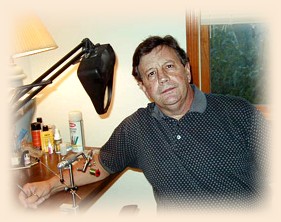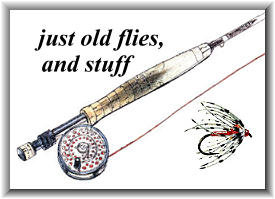We return to our old friend Francis Francis this week, and
his Book on Angling for a fly designed for the
Ness. Yes, this is the Ness of Loch Ness fame in Scotland,
and he describes the river as follows:
"The Ness is a large and heavy river issuing from a very
large lake, Loch Ness, which is fed by several good salmon
streams, of which the Garry is perhaps the most noteworthy.
The Garry is an excellent early spring river, whereas the
Ness, through which all the Garry fish run, is, but an
indifferent one. The Ness is a fair summer river, and
also gives plenty of grilse and large sea-trout to the rod;
later on, the salmon run of the largest size. The streams,
and pools on the Ness are remarkably fine and bold. The
casts are mostly fished from a boat, though, in places, they
can be fished from the shore."
All of this I find quite stunning, because I know I saw a
documentary on television looking into the question of the
Loch Ness monster. It was pointed out that the monster
couldn't possibly exist because Loch Ness was complete
devoid of fish, and there would be nothing on which the
monster could feed. Apparently, that documentary filmmaker
hadn't a clue, or something's changed drastically for the
worse since 1867, I'm not sure which.
The monster aside, the creator of the fifth fly listed for
the Ness is also something of a mystery. Francis Francis
says quite cryptically, at the end of the recipe for fly #8,
"The above patterns, with an exception or two, are from
the selection of my worthy gossip Snowie, of Inverness." So
this fly might have been Snowie's, or might not. Regardless
of who the true inventor was, it's a pretty one, a "capital
fly" as Francis Francis would put it, and when fishing the
Ness I would imagine one could always hold out the hope of
bagging a monster during the salmon runs, if not THE monster.
I'm going to list the recipe here exactly as it's shown in
the book, to give you an idea what you're facing when trying
to put together one of these flies from the old books. Seal
was apparently not a material used often by the fly dressing
acquaintances of Francis Francis, instead, pig's wool was the
order of the day. I have some actual pig's wool, harvested
and dyed by William Bailey of Fort Wayne Indiana. It's marvelous
stuff really, more wiry and curly than seal, perhaps an even
better material for use with these flies than seal, I don't know.
The use of seal supplanted pig's wool in the manufacture of full
dress flies as time went on, and seal is always a good substitute.
Anyway, I'll explain some things about the recipe using brackets.
No. 5. Tag, silver tinsel and blue floss; tail, one topping
[this means golden pheasant crest]; butt, black ostrich; body,
three turns of gold-coloured(sic) floss[the rear 2/3 or so
of the body is gold floss]; the rest bright yellow pig's wool;
silver tinsel [silver tinsel rib]; orange-yellow hackle over
the wool only [hackle starts where the pig's wool starts],
with a purple claret at shoulder [hackle wound at the front
of the fly, just before the wing, sometimes after]; mixed
wing [married wing] of gold pheasant tail, pintail, gallina
fibres(sic), red, yellow, and orange swan fibres(sic)
[some tiers actually marry ALL of these, others marry the
longer ones that are more easily married, taking the gallina
(guinea) and pintail and marrying those "sides," as I've done
here]; kingfisher cheeks; and blue macaw ribs [horns in later
lexicography].
As you can see, many things are assumed in these recipes,
and some are left to your own interpretation. He makes no
mention of a topping for this fly, but I've used my artistic
license and added one, as was customary. I've just gotten my
license back, after it was confiscated at the border by customs,
on a recent trip to Canada. They were looking for contraband
Worhol, and I fit the profile. It's no easy task to figure
out some of these recipes, or to come up with a plan for
putting the materials together. I think the thing that many
of us do is look at as many old pictures as we can find,
getting an idea of what was common practice, and going
from there. It's a process, and the rewards are great.
Credits: A Book on Angling by Francis Francis.
~ EA
About Eric:
 I started fly fishing as a teen in and around my hometown
of Plattsburgh, New York, primarily on the Saranac River.
I started tying flies almost immediately and spent hours
with library books written by Ray Bergman, Art Lee, and
A. J. McClane. Almost from the beginning I liked tying
just as much as I liked fishing and spent considerable
time at the vise creating hideous monstrosities that
somehow caught fish anyway. Then one day I came upon a
group of flies that had been put out at a local drug store
that had been tied by Francis Betters of Wilmington, N.Y.
My life changed that day and so did my flies, dramatically.
Even though I never met Fran back then, I've always
considered him to be one of my biggest influences.
I started fly fishing as a teen in and around my hometown
of Plattsburgh, New York, primarily on the Saranac River.
I started tying flies almost immediately and spent hours
with library books written by Ray Bergman, Art Lee, and
A. J. McClane. Almost from the beginning I liked tying
just as much as I liked fishing and spent considerable
time at the vise creating hideous monstrosities that
somehow caught fish anyway. Then one day I came upon a
group of flies that had been put out at a local drug store
that had been tied by Francis Betters of Wilmington, N.Y.
My life changed that day and so did my flies, dramatically.
Even though I never met Fran back then, I've always
considered him to be one of my biggest influences.
I had a career in music for twenty years or so and didn't
fish much, though I did fish at times. The band I was with
had its fifteen seconds of fame when we were asked to be in
John Mellencamp's movie "Falling From Grace." I am the
keyboard player on the right in the country club scene in
the middle of the movie. Don't blink. It's on HBO all the
time. We got to meet big Hollywood stars and record in John's
studio. It was a blast.
So how did I wind up contributing to the Just Old Flies
column on FAOL? I'm not sure, it was something that I simply
wanted very badly to do, and they let me. Many of the old flies
take me back to the Adirondacs and my youth, and I guess I get
to relive some of it through the column. I've spent many happy
hours fishing and tying over the years, and tying these flies
brings back memories of great days on the water, and intense
hours spent looking at the flies in the fly plates in the old
books and trying to get my flies to look like them. And now,
here I am, still doing that to this day. ~ EA
|


 I started fly fishing as a teen in and around my hometown
of Plattsburgh, New York, primarily on the Saranac River.
I started tying flies almost immediately and spent hours
with library books written by Ray Bergman, Art Lee, and
A. J. McClane. Almost from the beginning I liked tying
just as much as I liked fishing and spent considerable
time at the vise creating hideous monstrosities that
somehow caught fish anyway. Then one day I came upon a
group of flies that had been put out at a local drug store
that had been tied by Francis Betters of Wilmington, N.Y.
My life changed that day and so did my flies, dramatically.
Even though I never met Fran back then, I've always
considered him to be one of my biggest influences.
I started fly fishing as a teen in and around my hometown
of Plattsburgh, New York, primarily on the Saranac River.
I started tying flies almost immediately and spent hours
with library books written by Ray Bergman, Art Lee, and
A. J. McClane. Almost from the beginning I liked tying
just as much as I liked fishing and spent considerable
time at the vise creating hideous monstrosities that
somehow caught fish anyway. Then one day I came upon a
group of flies that had been put out at a local drug store
that had been tied by Francis Betters of Wilmington, N.Y.
My life changed that day and so did my flies, dramatically.
Even though I never met Fran back then, I've always
considered him to be one of my biggest influences.